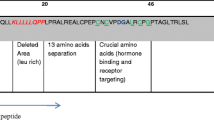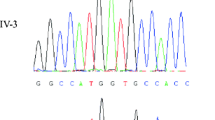Abstract
Reduced conversion of testosterone (T) to dihydrotestosterone (DHT) results in defective virilization in karyotypic males. Different mutations in the 5α-reductase type 2 gene cause the phenotypic variability of the disease. In this report we describe four prepubertal patients with a predominantly male phenotype who carry homozygous point mutations in the 5α-reductase type 2 gene and address the specific T and DHT response to different human chorionic gonadotropin (hCG) stimulation tests. For molecular genetic analysis, DNA from peripheral blood leucocytes was studied. The coding region of the 5α-reductase type 2 gene was characterized by exon-specific polymerase chain reaction amplification, non-radioactive single strand polymorphism analysis, and direct sequencing. Three different homozygous point mutations (Gly196−Ser, Arg227−Gln and Ala228−Thr) were identified in the patients. In contrast, in the DNA from 100 phenotypically normal males only two heterozygous abnormalities (Ile196−Ile, ΔMet157) were characterized. For hormonal studies, T and DHT were measured in serum before and after hCG stimulation employing different protocols. HCG stimulation with 5000 IU/m2 once and prolonged stimulation with seven injections of 1500 IU hCG per single dose every other day were used.
Conclusion
While abnormal T/DHT ratios were identified with both hCG protocols in the patients, prolonged stimulation lead to higher T values and to higher T/DHT ratios, and hence to a better discrimination of pathologic results.
Similar content being viewed by others
Abbreviations
- DHT :
-
dihydrotestosterone
- hCG :
-
human chorionic gonadotropin
- PCR :
-
polymerase chain reaction
- SHBG :
-
sex hormone-binding globulin
- SSCP :
-
single strand conformation polymorphism
- T :
-
testosterone
References
Andersson S, Russell DW (1990) Structural and biochemical properties of cloned and expressed human and rat steroid 5α-reductases. Proc Natl Acad Sci (USA) 87:3640–3644
Andersson S, Berman DM, Jenkins EP, Russell DW (1991) Deletion of steroid 5α-reductase 2 gene in male pseudohermaphroditism. Nature 354:159–161
Carpenter TO, Imperato-McGinley J, Boulware SD, Weiss RM, Shackleton C, Griffin JE, Wilson JD (1990) Variable expression of 5α-reductase deficiency: Presentation with male phenotype in a child of greek origin. J Clin Endocrinol Metab 71:318–322
Forest M (1979) Pattern of the response of testosterone and its precursors to human chorionic gonadotropin stimulation in relation to age in infants and children. J Clin Endocrinol Metab 49:132–137
Forest MG, David M, David L, Chartelain PG, Francois R, Bertrand J (1988) Undescended testis: comparison of two protocols of treatment with human chorionic gonadotropin. Horm Res 30: 198–206
Forest MG, Mollard P, David M, Morel Y, Bertrand J (1990) Syndrome d'insensibilitè incompléte aux androgènes. Arch Fr Pediatr 47:107–113
Grant DB, Laurance BM, Atherden SM, Ryness J (1976) HCG stimulation test in children with abnormal sexual development. Arch Dis Child 67:596–601
Greene S, Zachmann M, Manella B, Hesse V, Hoepffner W, Willgerodt H, Prader A (1987) Comparison of two tests to recognize or exclude 5α-reductase deficiency in prepubertal children. Acta Endocrinol (Copenh) 114:113–117
Hiort O, Huang Q, Sinnecker GHG, Sadeghi-Nejad A, Kruse K, Wolfe HJ, Yandell DW (1993) Single strand conformation polymorphism analysis of androgen receptor gene mutations in patients with androgen insensitivity syndromes: application for diagnosis, genetic counseling, and therapy. J Clin Endocrinol Metab 77:262–266
Hiort O, Wodtke A, Struve D, Zöllner A, Sinnecker GHG (1994) Detection of androgen receptor gene mutations using non-isotopic single strand conformation polymorphism analysis. Hum Molec Genet 3:1163–1166
Ivarsson SA, Nielsen MD, Lindberg T (1988) Male pseudohermaphroditism due to 5α-reductase deficiency in a Swedish family. Eur J Pediatr 147: 532–535
Jenkins EP, Hsieh CL, Milatovich A, Normington K, Berman DM, Francke U, Russell DW (1991) Characterization and chromosomal mapping of a human steroid 5α-reductase gene and pseudogene and mapping of the mouse homologue. Genomics 11:1102–1112
Jenkins EP, Andersson S, Imperato-McGinley J, Wilson JD, Russell DW (1992) Genetic and pharmacological evidence for more than one human steroid 5α-reductase. J Clin Invest 89:293–300
Labrie F, Sugimoto Y, Luu-The V, Simard J, Lachance Y, Bachvarov D, Leblanc G, Durocher F, Paquet N (1992) Structure of human type II 5α reductase gene. Endocrinology 131: 1571–1573
Moore RJ, Wilson JD (1976) Steroid 5α-reductase in cultured human fibroblasts. Biochemical and genetic evidence for two distinct enzyme activities. J Biol Chem 251:5895–5900
Ng WK, Taylor NF, Hughes IA, Taylor J, Ransley PG, Grant DB (1990) 5α-reductase deficiency without hypospadias. Arch Dis Child 65:1166–1167
Odame I, Donaldson MDC, Wallace AM, Cochran W, Smith PJ (1992) Early diagnosis and management of 5α-reductase deficiency. Arch Dis Child 67:720–723
Pang S, Levine LS, Chow D, Sagiani F, Saenger P, New MI (1979) Dihydrotestosterone and its relationship to testosterone in infancy and childhood. J Clin Endocrinol Metab 48:821–826
Saenger P, Goldman AS, Levine LS, Korth-Schulz S, Muecke EC, Katsumata M, Doberne Y, New MI (1978) Prepubertal diagnosis of steroid 5α-reductase deficiency. J Clin Endocrinol Metab 46:627–634
Saez JM, Bertrand J (1968) Studies on testicular function in children: plasma concentrations of testosterone, dehydroepiandrosterone and its sulfate before and after stimulation with human chorionic gonadotropin. Steroids 12: 749–761
Sinnecker G, Köhler S (1989) Sex hormone-binding globulin response to the anabolic steroid stanozolol: evidence for its suitability as a biological androgen sensitivity test. J Clin Endocrinol Metab 68:1195–1200
Thigpen A, Davis DL, Gautier T, Imperato-McGinley J, Russell DW (1992) Brief report: the molecular basis of steroid 5α-reductase deficiency in a large dominican kindred. N Engl J Med 327:1216–1219
Thigpen A, Davis DL, Milatovich A, Mendonca BB, Imperato-McGinley J, Griffin JE, Francke U, Wilson JD, Russell DW (1992) Molecular genetics of steroid 5α-reductase 2 deficiency. J Clin Invest 90:799–809
Wigley WC, Prihoda JS, Mowszowicz I, Mendonca BB, New MI, Wilson JD, Russell DW (1994) Natural mutagenesis study of the human steroid 5α-reductase 2 isoenzyme. Biochemistry 33: 1265–1270
Wilson JD, Griffin JE, Russell DW (1993) Steroid 5α-reductase 2 deficiency. Endocrinol Rev 14:577–593
Author information
Authors and Affiliations
Rights and permissions
About this article
Cite this article
Hiort, O., Willenbring, H., Albers, N. et al. Molecular genetic analysis and human chorionic gonadotropin stimulation tests in the diagnosis of prepubertal patients with partial 5α-reductase deficiency. Eur J Pediatr 155, 445–451 (1996). https://doi.org/10.1007/BF01955179
Received:
Accepted:
Issue Date:
DOI: https://doi.org/10.1007/BF01955179




